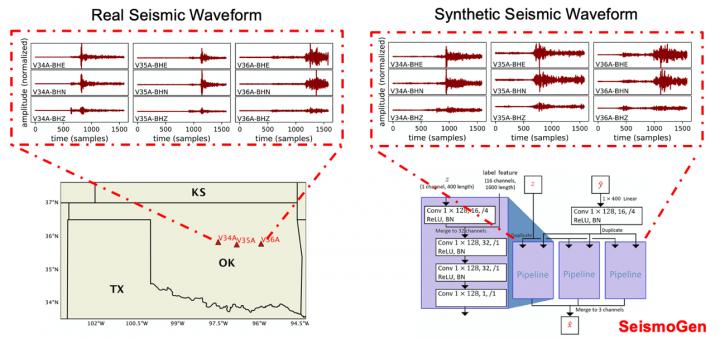A new machine-learning model that generates realistic seismic waveforms will reduce manual labor and improve earthquake detection, according to a study published recently in JGR Solid Earth.
“To verify the efficacy of our generative model, we applied it to seismic field data collected in Oklahoma,” said Youzuo Lin, a computational scientist in Los Alamos National Laboratory’s Geophysics group and principal investigator of the project. “Through a sequence of qualitative and quantitative tests and benchmarks, we saw that our model can generate high-quality synthetic waveforms and improve machine learning-based earthquake detection algorithms.”
Quickly and accurately detecting earthquakes can be a challenging task. Visual detection done by people has long been considered the gold standard, but requires intensive manual labor that scales poorly to large data sets. In recent years, automatic detection methods based on machine learning have improved the accuracy and efficiency of data collection; however, the accuracy of those methods relies on access to a large amount of high-quality, labeled training data, often tens of thousands of records or more.
To resolve this data dilemma, the research team developed SeismoGen based on a generative adversarial network (GAN), which is a type of deep generative model that can generate high-quality synthetic samples in multiple domains. In other words, deep generative models train machines to do things and create new data that could pass as real.
Once trained, the SeismoGen model is capable of producing realistic seismic waveforms of multiple labels. When applied to real Earth seismic datasets in Oklahoma, the team saw that data augmentation from SeismoGen-generated synthetic waveforms could be used to improve earthquake detection algorithms in instances when only small amounts of labeled training data are available.
Researchers use AI to estimate focal mechanism parameters of earthquake
More information:
Tiantong Wang et al, SeismoGen: Seismic Waveform Synthesis Using GAN With Application to Seismic Data Augmentation, Journal of Geophysical Research: Solid Earth (2021). DOI: 10.1029/2020JB020077
Provided by
Los Alamos National Laboratory
Citation:
Machine learning model generates realistic seismic waveforms (2021, April 22)
retrieved 22 April 2021
from https://phys.org/news/2021-04-machine-realistic-seismic-waveforms.html
This document is subject to copyright. Apart from any fair dealing for the purpose of private study or research, no
part may be reproduced without the written permission. The content is provided for information purposes only.
